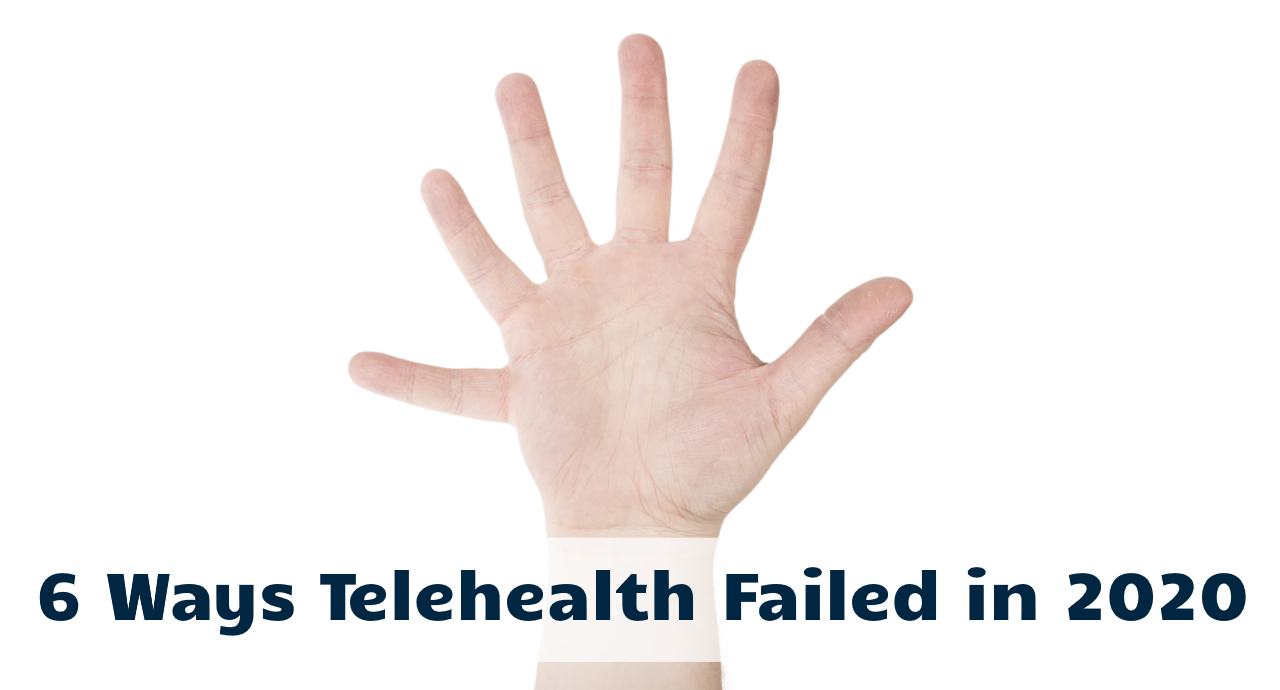On many accounts, 2020 was the year of telehealth. In response to the Covid-19 health crisis, a quick solution was needed to safely provide care for patients, especially those that did not need “hands-on” care, but standard medical care. Yet compared to how good it can be, telehealth failed in 2020 in 6 different ways:
- Inefficient Telecare Workflows
- Haphazard Technology Choices
- Low Physician Acceptance
- Inadequate Telephonic Care
- Mediocre patient experience
- No Long-term Strategy
1. Inefficient Telecare Workflows
Care delivery is primarily a set of connected workflows to provide a great experience for clinicians and patients alike. From the scheduling of appointments to the pre-visit, post-visit and follow-up actions, care delivery — whether in person or at a distance — is a series of administrative and clinical workflows.
In the majority of organizations that jumped into telehealth quickly, little thought was given to identify the differences between in-person and virtual care and to make the necessary modifications to the traditional workflows. This was the first fail of telehealth.
2. Haphazard Technology Choices
When organizations were pressed to quickly stand up the capacity to provide “care at a distance” they either turned to solutions already offered by existing vendors (such as the EMR or enterprise video conferencing technology (not optimized for healthcare)) or bought licenses to consumer-grade video conferencing solutions.
Typically neither approach yielded the appropriate set of technologies that suited the needs of clinicians, nurses, schedulers, and patients “sustainably”. Unfortunately, 9 months into the health crisis and given the second surge of Covid-19 infections, the hodgepodge of quickly assembled technology solutions are still in place, oftentimes still frustrating both clinicians and patients. The second major fail.
3. Low Physician Acceptance
For years, many physicians had been leery of telehealth technology to really being able to replace in person visits. After the frustrating experience with the insertion of the EMR technology into the consult, I have found many physicians highly apprehensive regarding the use of technology for the delivery of care.
This apprehension very quickly resurfaced after the initial auto-pilot acceptance of telehealth as it was better than not being able to provide care at all. As the use of telehealth with poorly defined workflows and hastily selected technologies continued, we repeatedly heard a steep decline in patient satisfaction and acceptance of telehealth, albeit oftentimes self-reported by the physicians.
4. Inadequate Telephonic Care
During the height of the first Covid-19 wave it was disheartening to learn of the high percentage (oftentimes 99%) of clinicians refusing to use video and resorting to phone only virtual care. While this may be a great stop-gap measure to check in with patients and ask them about symptoms or whether they needed a refill, telephonic care, even if reimbursed, cannot serve as a longer-term care strategy.
Besides, many telephonic reimbursement codes are significantly lower than live audio/video telecare and even where they are temporarily allowed, they are certain to go away as soon as the Covid-19 health crisis lets up due to the rollout of the vaccine.



5. Mediocre Patient Experience
The mediocre experience by many healthcare consumers — which was met with patience by many patients in exchange for the safety and convenience — was caused by a number of factors. Predominantly the root cause of a poor patient experience lies in “all of the above” examples of telehealth failure.
Haphazard workflows led to confusion and inadequate flow of critical information. Hastily chosen technologies were not evaluated for patient fit, especially when it comes to poor connectivity in rural areas. Long-held doubts about telehealth harbored by many clinicians created a self-fulfilling prophecy where patients did not get the same level of care they expected. This included a high use of telephonic care, even though video would have been the appropriate level of care.
6. No Long-term Strategy
The 6th failure of telehealth in 2020 pertains to the lack of a long-term telehealth strategy by many organizations. Especially smaller hospitals and rural health centers oftentimes still regard telehealth as a necessary evil stop gap measure that will go back to single-digit uses once this health crisis is over. Very few are taking the time to build out a longer-term connected health strategy that takes advantage of the patients’ acceptance of this form of care.
What these organizations fail to realize and capitalize on is that telehealth is here to stay big time and forever. And if patients cannot get the care when they need it and where they want it, they will turn to other clinicians. Multiple innovative, venture capital-funded clinical service providers are already finding their way onto the modern healthcare consumer’s smartphone, tablet, or smart TV.
Opportunities in 2021
With the deployment of a vaccine just around the corner, hopes are high that things are going to return to a (new) normal in 2021. While “care at a distance” cannot solve all of our ambulatory/outpatient challenges, it can handle a very high percentage of new patients really well.
We here at Ingenium are bracing ourselves for a continued stream of opportunities to help healthcare organizations to make the most out of telehealth and to make it part of their overall, long-term strategy.
Because “It’s very clear, telehealth is here to stay. Not for a year, but ever and a day.”








To receive articles like these in your Inbox every week, you can subscribe to Christian’s Telehealth Tuesday Newsletter.
Christian Milaster and his team optimize Telehealth Services for health systems and physician practices. Christian is the Founder and President of Ingenium Digital Health Advisors where he and his expert consortium partner with healthcare leaders to enable the delivery of extraordinary care.
Contact Christian by phone or text at 657-464-3648, via email, or video chat.







Leave A Comment